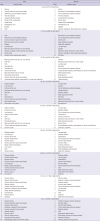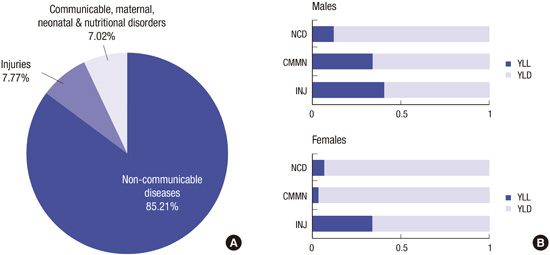1. Omran AR. The epidemiologic transition. A theory of the epidemiology of population change. Milbank Mem Fund Q. 1971; 49:509–538.
2. Murray CJ. Summary Measures of Population Health: Concepts, Ethics, Measurement and Applications. Geneva: World Health Organization;2002.
3. Murray CJ, Lopez AD. The Global Burden of Disease: a Comprehensive Assessment of Mortality and Disability from Diseases, Injuries and Risk Factors in 1990 and Projected to 2020. Cambridge, MA: Harvard University Press;1996.
4. Lopez AD, Mathers CD, Ezzati M, Jamison DT, Murray CJ. Global Burden of Disease and Risk Factors. Washington, D.C.: The International Bank for Reconstruction and Development/The World Bank;2006.
5. Mathers CD, Vos ET, Stevenson CE, Begg SJ. The burden of disease and injury in Australia. Bull World Health Organ. 2001; 79:1076–1084.
6. Murray CJ, Vos T, Lozano R, Naghavi M, Flaxman AD, Michaud C, Ezzati M, Shibuya K, Salomon JA, Abdalla S, et al. Disability-adjusted life years (DALYs) for 291 diseases and injuries in 21 regions, 1990-2010: a systematic analysis for the global burden of disease study 2010. Lancet. 2012; 380:2197–2223.
7. Melse JM, Essink-Bot ML, Kramers PG, Hoeymans N; Dutch Burden of Disease Group. A national burden of disease calculation: Dutch disability-adjusted life-years. Am J Public Health. 2000; 90:1241–1247.
8. Murray CJ, Lopez AD. Global Comparative Assessments in the Health Sector: Disease Burden, Expenditures, and Intervention Packages. Geneva: World Health Organization;1994.
9. Murray CJ, Lopez AD. Measuring the global burden of disease. N Engl J Med. 2013; 369:448–457.
10. Statistics Korea. Korean statistical information service [Internet]. accessed on 11 November 2015. Available at
http://kosis.kr/.
12. Begg SJ, Vos T, Barker B, Stanley L, Lopez AD. Burden of disease and injury in Australia in the new millennium: measuring health loss from diseases, injuries and risk factors. Med J Aust. 2008; 188:36–40.
13. Mathers CD, Vos T, Lopez AD, Salomon J, Ezzati M. National Burden of Disease Studies: a Practical Guide; Edition 2.0. Geneva: World Health Organization;2001.
14. Kim SH, Lee HJ, Ock M, Go DS, Kim HJ, Lee JY, Jo MW. Disability-Adjusted Life Years for Maternal, Neonatal, and Nutritional Disorders in Korea. J Korean Med Sci. 2016; 31:Suppl 2. S184–S190.
16. World Health Organization. WHO Methods and Data Sources for Global Burden of Disease Estimates 2000-2011. Geneva: World Health Organization;2013.
17. Murray CJ, Ezzati M, Flaxman AD, Lim S, Lozano R, Michaud C, Naghavi M, Salomon JA, Shibuya K, Vos T, et al. GBD 2010: design, definitions, and metrics. Lancet. 2012; 380:2063–2066.
18. Ock M, Lee JY, Oh IH, Park H, Yoon SJ, Jo MW. Disability Weights Measurement for 228 Causes of Disease in the Korean Burden of Disease Study 2012. J Korean Med Sci. 2016; 31:Suppl 2. S129–S138.
19. Lee YR, Kim YA, Park SY, Oh CM, Kim YE, Oh IH. Application of a Modified Garbage Code Algorithm to Estimate Cause-Specific Mortality and Years of Life Lost in Korea. J Korean Med Sci. 2016; 31:Suppl 2. S121–S128.
20. National Health Insurance Services (KR). Major statistics on national health insurance services: 2012 [Internet]. accessed on 11 November 2015. Available at
http://www.nhis.or.kr.
21. National Cancer Center (KR). Annual Report of Cancer Statistics in Korea in 2012. Ilsan: National Cancer Center;2014.
22. Lee WK, Lim D, Park H. Disability-Adjusted Life Years (DALYs) for Injuries Using Death Certificates and Hospital Discharge Survey by the Korean Burden of Disease Study 2012. J Korean Med Sci. 2016; 31:Suppl 2. S200–S207.
23. Barendregt JJ, Van Oortmarssen GJ, Vos T, Murray CJ. A generic model for the assessment of disease epidemiology: the computational basis of DisMod II. Popul Health Metr. 2003; 1:4.
24. National Health Insurance Service (KR). Health Insurance Review & Assessment Service (KR). Health Insurance Statistical Yearbook 2012. National Health Insurance Service; Health Insurance Review & Assessment Service;2013.
26. Ezzati M, Riboli E. Can noncommunicable diseases be prevented? Lessons from studies of populations and individuals. Science. 2012; 337:1482–1487.
27. Kim EJ, Yoon SJ, Jo MW, Kim HJ. Measuring the burden of chronic diseases in Korea in 2007. Public Health. 2013; 127:806–813.
28. Yoon SJ, Bae SC, Lee SI, Chang H, Jo HS, Sung JH, Park JH, Lee JY, Shin Y. Measuring the burden of disease in Korea. J Korean Med Sci. 2007; 22:518–523.
29. Yoon J, Seo H, Oh IH, Yoon SJ. The Non-Communicable Disease Burden in Korea: Findings from the 2012 Korean Burden of Disease Study. J Korean Med Sci. 2016; 31:Suppl 2. S158–S167.
30. Vos T, Barber RM, Bell B, Bertozzi-Villa A, Biryukov S, Bolliger I, Charlson F, Davis A, Degenhardt L, Dicker D. Global, regional, and national incidence, prevalence, and years lived with disability for 301 acute and chronic diseases and injuries in 188 countries, 1990-2013: a systematic analysis for the global burden of disease study 2013. Lancet. 2015; 386:743–800.
31. March L, Smith EU, Hoy DG, Cross MJ, Sanchez-Riera L, Blyth F, Buchbinder R, Vos T, Woolf AD. Burden of disability due to musculoskeletal (MSK) disorders. Best Pract Res Clin Rheumatol. 2014; 28:353–366.
32. Hoy D, Geere JA, Davatchi F, Meggitt B, Barrero LH. A time for action: opportunities for preventing the growing burden and disability from musculoskeletal conditions in low- and middle-income countries. Best Pract Res Clin Rheumatol. 2014; 28:377–393.
33. Lim D, Lee WK, Park H. Disability-adjusted Life Years (DALYs) for Mental and Substance Use Disorders in the Korean Burden of Disease Study 2012. J Korean Med Sci. 2016; 31:Suppl 2. S191–S199.
34. Yoon J, Yoon SJ. Quantifying Burden of Disease to Measure Population Health in Korea. J Korean Med Sci. 2016; 31:Suppl 2. S101–S107.











 PDF
PDF Citation
Citation Print
Print




 XML Download
XML Download